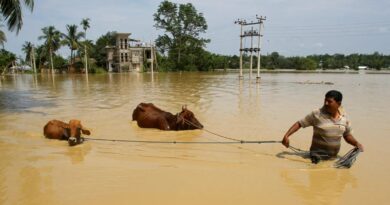Groundwater may fall below 100m in north west India
Ground water found at a depth of about 100 metres in north-west India will be exhausted within the next 10 years, according to a draft report of the Central Ground Water Board (CGWB) that highlights its over-exploitation in the region.
The report, which has been submitted to state governments, draws on data recorded between 1994 and May 2018 and shows that withdrawal of groundwater has been greater than recharge.
The report, which has been submitted to state governments, draws on data recorded between 1994 and May 2018 and shows that withdrawal of groundwater has been greater than recharge — against an annual gross groundwater withdrawal of 35.78 billion cubic meters (BCM), the annual recharge has only been 21.58 BCM.
According to the report, groundwater level has been falling at the rate of 51cm every year and, at present, it is at a depth of 10-65 metres in the region.
Over the past decade, an increase in the frequency of drought-like situations has led to an increase in withdrawal of groundwater. The India Meteorological Department reports (2012-2017)on rainfall patterns show that Himachal and Uttarakhand has received 25%-40% rainfall while Punjab, Haryana and parts of Rajasthan have received 15%-20% rainfall.
The impact is clearly visible in the groundwater data released by the CGWB for these states.
In Punjab, the districts of Ludhiana, Jalandhar, Kapurthala, Nawashahr, Sangrur, Patiala and Barnala are in the red for over-exploitation of groundwater. “The report is alarming and clearly states that groundwater at a depth of 100 metres will end in the next 10 years if the present rate of withdrawal continues,” said a Punjab water resources department official, who was not willing to be quoted.
Likewise in Haryana, the districts of Sirsa, Yamunanagar, Karnal, Kurukshetra, Gurugram, Faridabad, Bhiwani, Rewari are in the red for over-exploitation of groundwater. In certain parts of Haryana, such as Sirsa, the groundwater situation is worse than that of Punjab.
In the entire agriculture belt of northern and western Rajasthan, groundwater levels have fast depleted and are now in a critical stage. Except the tribal belt of southern Rajasthan and parts of eastern Rajasthan, the entire state has a groundwater emergency, according to latest data on the CGWB website.
In Delhi, only the southern parts are in the red. There has been an improvement in groundwater levels in north-western and eastern parts of the national capital. Most of the areas that the Central Ground Water Authority has notified as having “critical” groundwater levels are in these four states.
The falling groundwater levels in these states will have implications on supply of drinking water as well as agriculture as over a million tubewells provide water for both. Though Haryana and Punjab have irrigation facilities, a large part of Rajasthan is totally dependent on groundwater for its needs.
P Nandkumaram, member-secretary of the CGWB, said the groundwater assessment report has been submitted to the water resources ministry. He refused to divulge details pending vetting of the report by the ministry.
“The situation is bad but not alarming,” said a senior scientist with the board who was not willing to be quoted as he was not authorised to speak to the media. “If we continue to exploit groundwater the way we are doing in an unsustainable manner, we are heading for disaster. We can sustain water at 50-60 metres below the ground but for that some regulation is needed.”
Himanshu Thakkar, an IIT alumnus, who runs a non-government organization South Asia Network of People, Rivers and Dams, said farmers’ over-dependence on groundwater was the prime reason for depletion. “Even though India receives good rainfall every year, in many regions water is now available more than 100 metres below the ground. In some places, it is even more than 200 metres. The situation clearly shows that there is mismanagement, not proper use of rain water and gross misuse of groundwater, which is India’s water lifeline,” he said.
The CWGB report said at the current rate of extraction, all available groundwater resources till a depth of 300 metres in Punjab, Haryana and Rajasthan will be exhausted in the next 20-25 years. The extraction of ground water in the region has increased from 149% in 2013 to 165% in 2018, the report said.
Nationally, the situation is slightly better. Against the annual groundwater availability of 411 BCM, the annual withdrawal is estimated to be 253 BCM. The board has observation wells at 30,000 locations in India, providing data on 16 attributes for four seasons in a year.
Source: hindustantimes.com




